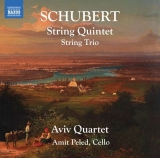Franz Schuberts komponierte sein Streichtrio 1817, also im Alter von 20 Jahren. Es ist ein schönes, ganz besonders delikates und im Grunde klassizistisches Werk, mit gelegentlichen romantischen Verzierungen. Das russisch-französisch-israelische Aviv Quartet (ohne seinen zweiten Geiger Philippe Villafranca) muss dieses Trio sehr lieben, denn es behandelt es so zart, wie man nur jemand ‘streichelt’, den man sehr mag. In dem hinreißend kantablen und lieblichen Spiel treten die düsteren Episoden und Seufzern umso effektvoller hervor. Die Anleihen in der österreichischen Tanzmusik hat man volkstümlicher gehört, aber hier werden sie so veredelt, dass man nur beglückt zuhören kann.
Haben die Seufzer im Trio noch einen eher dekorativen und opernhaften Charakter, dringt Schubert im Streichquintett D 956 in tiefste emotionale Bereiche vor. Das Aviv Quartet und Amit Peled am 2. Cello bringen das nicht so sehr dramatisch und aufgeregt zum Ausdruck (wie z.B. das Vogler-Quartett und Müller-Schott) als vielmehr verinnerlicht und mit reflektiver Äußerung des Schmerzes.
Und wie könnte man im Adagio nicht an die resignierende Notiz von Schubert denken: « … jene [Werke], welche der Schmerz allein erzeugt hat, scheinen am wenigsten die Welt zu erfreuen. » Das zwei Monate vor seinem Tod komponierte Quintett blieb in der Tat zunächst erfolglos. Erst 1850 wurde das Quintett in Wien öffentlich aufgeführt, erst 1853 wurde es gedruckt.
« Denke dir einen Menschen, sage ich, dessen glänzendste Hoffnungen zunichte geworden sind, dem das Glück der Liebe u. Freundschaft nichts bieten als höchstens Schmerz.“ Schubert bringt das in diesem Adagio vorerst sehr verträumt zum Ausdruck. Der f-Moll-Mittelteil haben andere Interpreten harscher und kantiger gespielt, aber die Avivs bleiben auch hier verhaltener, als reiche Schuberts Kraft zum dramatischen Schrei nicht aus, als bleibe gerade mal genug davon, um sich aufzubäumen. Danach wird die Musik wohl etwas unruhiger, aber die fünf Musiker ziehen hier eine zarte, ungemein traurige hilflos resignierende Stimmung auf, die beim Zuhörer höchstes Mitgefühl hervorruft.
Im konfliktuellen Scherzo spielen die Musiker durchaus zupackend und drängend, um im Trio, einem Andante sostenuto, von zunächst sehr düsteren Gedanken zu einem fast flehenden, doch gleichzeitig hoffnungslosen Gesang zu finden.
Das Finale ist tänzerisch. Doch die schillernden Farben und die Rhythmen täuschen in dieser tiefschürfenden Interpretation nicht darüber hinweg, dass dieses Rondo mehr Reminiszenz ist als der Ausdruck unmittelbarer Zufriedenheit, und in der beschwingten Coda höre ich mehr Verbitterung und Unmut als in anderen Aufführungen.
Und so froh und zufrieden das Trio den Zuhörer stimmt, so verwirrt lässt uns Quintett zurück, wenn die Musik geendet hat.
Franz Schubert composed his String Trio in 1817, at the age of 20. It is a beautiful, particularly delicate and basically classicistic work, with occasional romantic inserts. The Russian-French-Israeli Aviv Quartet (without its second violinist Philippe Villafranca) must love this trio very much, because it treats it as delicately as you can only ‘pet’ someone you deeply like. In the enchantingly cantabile and lovely playing, the dark episodes and sighs are all the more effective. The borrowings in Austrian dance music have been heard folksier, but here they are refined in such a way that one can only listen with pleasure.
If in the trio the sighs still have a more decorative and operatic character, the String Quintet penetrates into the deepest emotional realms. The Aviv Quartet and Amit Peled on the second cello express this not so much dramatically and excitedly (as, for example, the Vogler Quartet and Müller-Schott). Their playing is rather introverted, with a reflective expression of pain.
And how could one not think of Schubert’s resigned note in the Adagio: « …those [works] which pain alone has produced seem to please the world least of all ». Indeed, the quintet, composed two months before his death, was unsuccessful at first. It was not performed publicly until 1850, and was not printed until 1853.
« Think of a man, I say, whose brightest hopes have been dashed, to whom the happiness of love and friendship offer nothing but pain at best. » Schubert expresses this rather dreamily in the beginning of this Adagio. Other interpreters have played the F minor middle section more harshly and angularly, but the Avivs are more restrained here as well, as if Schubert was lacking power for dramatic screams, having just enough of it to express darker thoughts. The music becomes a bit more restless, but the five musicians create a tender, immensely sad, helplessly resigned mood, evoking in the listener deepest compassion with the composer.
In the conflictive scherzo, the performance is very gripping and urgent. The trio, an Andante sostenuto, is moving from initially very dark thoughts to an almost pleading but at the same time hopeless singing.
The finale is dance-like. But the shimmering colours and the rhythms in this profound interpretation do not hide the fact that this rondo is more of a reminiscence than an expression of immediate happiness, and I hear more bitterness and resentment in the lively coda than in other performances. And as happy and satisfied as the trio makes the listener feel, the quintet leaves us deeply confused when the music has ended.
Rezension von Uwe Krusch (♪♪♪♪)
Während das Streichquintett von Franz Schubert mit dem zum Quartett hinzugefügten zweiten Cello eines der herausragenden Werke der Kammermusik überhaupt ist, findet das Trio weniger Beachtung, wenngleich es, zehn Jahre früher entstanden, schon unzweifelhaft die Qualitäten des Komponisten zeigt. Beiden Besetzungen sind im Vergleich zur Anordnung im Quartett Eigenheiten zuzuschreiben, die bei der Komposition zu berücksichtigen sind. Das ist Schubert insbesondere beim Quintett ohne Abstriche gelungen.
Das seit gut zwanzig Jahren auftretende Aviv Quartet und mit ihm Amit Peled für die zweite Cellostimme haben die beiden Kompositionen mit musikantischem Esprit und hoher künstlerischer Qualität eingespielt. Ihnen gelingt eine ausgewogen feine Darstellung zwischen Ensembleklang und Beleuchtung der Einzelstimmen. So ist das Zuhören mehr als angenehm. Allerdings fehlt auch das Besondere, um es zu einer herausragenden Interpretation zu machen.
























